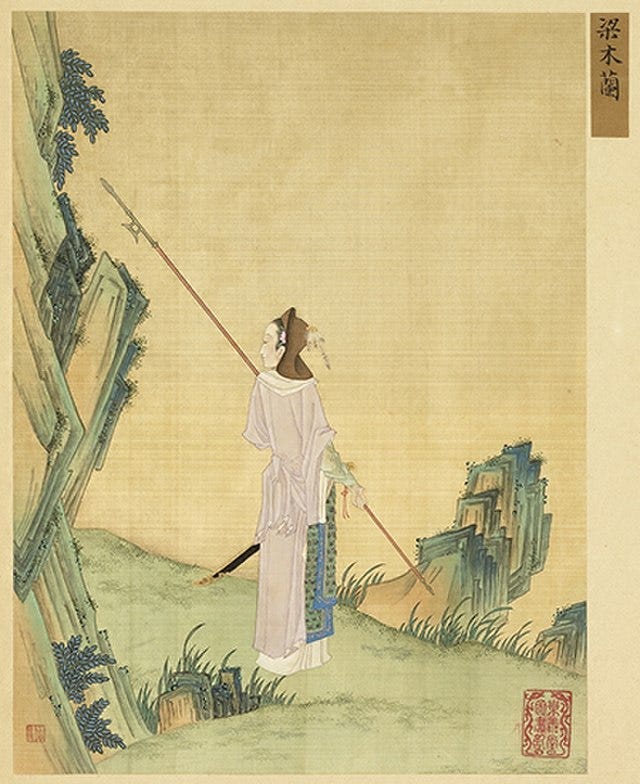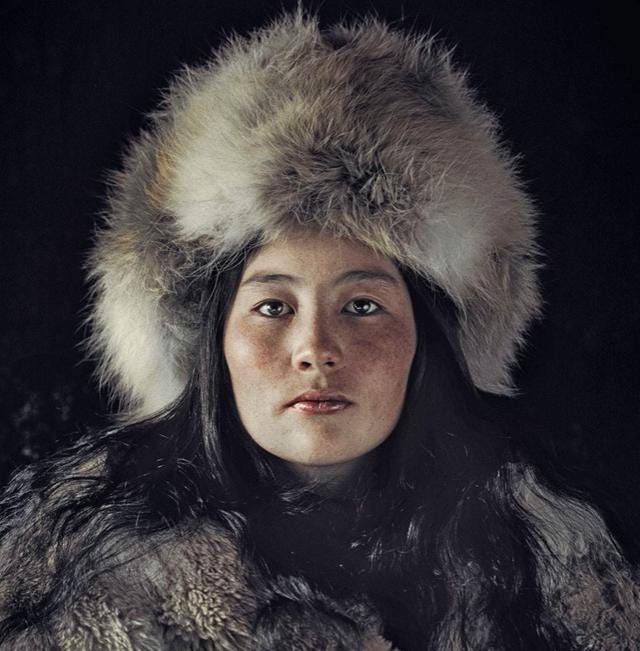The True History of Mulan
Was our Chinese Disney Princess even real? 👧🏻🗡️
We all know the history of Mulan thanks to Disney. Whether you are the live action fan or prefer the original animated version from 1998, we all agree that this brave Chinese girl has made a lasting impression on many of us.
Could Mulan be a historical character? Some people think so. However, whether you believe it or not, there are some things about the “original” Mulan that may surprise you.
Painting from Qing Dynasty depicting Mulan. Photo source: Wikimedia Commons
花木兰的传说,讲述的是一位年轻的女孩,代替父亲,乔装成男人为国家而战的故事。在最早版本中,花木兰去打了12年仗,然后回到了自己的家。
至于木兰的真实生活,有些人说她的故事只是一个传说。然而尽管花木兰的故事中有悲剧的元素,但几个世纪以来,她的故事却鼓舞了一代又一代的人。
这个故事很可能起源于中国的北魏时期( 386-535 年),之后由后来的作者开发。 学术界的共识是,花木兰是一个虚构的人物,可能是在中国北方发展起来的,以回应那里的女性享有更大的独立性。
乔装 (qiáozhuāng) - to disguise
鼓舞 (gǔwǔ) - to encourage, to boost
一代又一代 (yīdài yòu yīdài) - generations after generations
北魏时期 (Běiwèi shíqí) - Northern Wei Dynasty
虚构 (xūgòu) - imaginary, fictional
The legend of Hua Mulan tells the story of a young girl who disguises herself as a man (乔装成男人) to fight for her country in her father's place. In the earliest versions, Hua Mulan went to war for 12 years before returning to her home.
As for Mulan's real life, some say her story is just a legend. Yet despite the tragic elements of Hua Mulan's story, her story has inspired (鼓舞) generations aftter generations (一代又一代).
The story likely originated during China's Northern Wei Dynasty (北魏时期) (386-535) and was later developed by later authors. The scholarly consensus is that Hua Mulan is a fictional (虚构) character who may have been developed in northern China in response to the greater independence enjoyed by women there.
Although she stole our hearts, Disney Mulan may be far from the original’s historical realities. Photo source: Kawaii
原作《木兰诗》可追溯至公元 6 世纪,反映了蒙古-突厥民族对该地区的影响,重点关注孝道——故事的核心美德和寓意。 后来的《木兰歌》(唐朝, 618-907 年)保留了这一主题,同时改变了时间和重点。 这个传说后来被宋代郭茂谦(公元 960-1279 年)编纂成一部汇编,为其他作家的版本提供了原始资料。
追溯 (zhuīsù) - to trace back
突厥民族 (Tūjué mínzú) - Turkic people
孝道 (xiàodào) - filial piety, the virtue of exhibiting love and respect for one's parents, elders, and ancestors,
美德 (měidé) - a virtue; synonym: 道德
寓意 (yùyì) - a message, a moral of a story
宋代郭茂谦 (Sòngdài guōmàoqiān) - Guo Maoqian of Song Dynasty, a poetry anthologist
编纂 (biānzuǎn) - a compilation; synonym: 汇编 (huìbiān)
The original “Ballad of Mulan” dates to (追溯) the 6th century AD and reflects the Mongol-Turkic (突厥民族) influence on the region, focusing on filial piety (孝道), a core virtue (美德) and moral (寓意) of the story. The later Song of Mulan (Tang dynasty, 618-907 AD) retained this theme while changing the time period and emphasis. The legend was later made into a compilation (编纂) by Guo Maoqian (郭茂谦) (960-1279 AD) during the Song dynasty, providing source material for versions by other writers.
1. 木兰不是汉人
木兰不是汉人,木兰是鲜卑人。在中国的历史上,花木兰生活的国家,叫做“北魏”。北魏不是一个汉族国家。北魏是鲜卑人的国家。鲜卑人,是当时的游牧民族。木兰是游牧民族, 任何汉化的木兰形象,都和历史事实,是不相符的。
可是,尽管木兰是鲜卑人,由于鲜卑族在后来的历史长河里,逐渐融入了中华民族。
鲜卑人 (Xiānbēi rén) - The Xianbei, an ancient nomadic people that once resided in what is today Mongolia, Inner Mongolia, and Northeastern China
游牧 (yóumù) - nomadic
逐渐 (zhújiàn) - gradually
Mulan was not a Han Chinese, but a Xianbei (鲜卑人). In Chinese history, the country where Hua Mulan lived was called "Northern Wei". Northern Wei was not a Han Chinese country, but Xianbei’s. Xianbei people were nomadic (游牧), and so was Mulan. Any Han image of Mulan is inconsistent with historical facts.
However, although Mulan was a Xianbei, the Xianbei people gradually (逐渐) integrated into the Chinese nation in the long course of history.
Could it be how real Mulan would look like? Photo source: 163.com
2. 木兰在出征前,接受了多年的训练
当木兰接替父亲在军队服役时,她并不是一个新手。在《花木兰》最受欢迎的版本之一,木兰经过多年的训练成为了一名战士,然后奔赴战场。
出征 (chūzhēng) - to go on an expedition
服役 (fúyì) - a service; synonym: 服务
奔赴 (bēnfù) - to head off to, to hurry to
When Mulan takes over her father’s military service (军队服役), she’s already trained. In one of the most popular versions of the story, Mulan trains for years to become a warrior before heading off (奔赴) to war.
3. 在成为将军前,木兰就裹了脚
在一部写于公元420年至589年,关于木兰生平的戏剧中,花木兰在去战场前脱下了她的绑脚。
生平 (shēngpíng) - all one’s life
战场 (zhànchǎng) - a battlefield
绑脚 (bǎng jiǎo) - foot binding (see below)
In a play about Mulan's life (生平) written between 420 and 589 AD, she removes the bounds from her feet (绑脚) before going to battle (战场).
4. 木兰躲了12年没有被发现
在早期版本中,她成功地将自己装扮成男性长达12年之久。
在军队服役十多年后,木兰摘下头发,在脸上抹上黄色的花粉。然后她向伙伴们透露了她的秘密。
装扮 (zhuāngbàn) - dress up, be disguised as
摘下 (zhāi xià) - to take off, to remove
In an early version of the story, she successfully disguised herself (装扮) as a man for 12 years.
After serving in the army for more than a decade, Mulan removed her hair (摘下头发) and smeared yellow pollen on her face. She then revealed her secret to her companions.
As you can see, if she ever existed, Mulan probably wasn’t an elegant Han lady, but a nomad and a proficient horserider. Maybe going undiscovered in the army wasn’t so hard for her?
Let’s recall the past lesson about the Chinese tradition of foot binding:
三寸金莲(foot-binding,又称裹脚、缠小脚、裹小脚、绑脚, 扎脚),是中国古代一种陋习,是用布将女性双脚紧紧缠裹,使之畸形变小。一般女性从四、五岁起便开始缠足,直到成年骨骼定型后方将布带解开,也有终身缠裹者。
三寸金莲 (Sān cùn jīnlián, lit. “three-inch lotus”), 裹脚 (guǒjiǎo)、缠小脚 (chán xiǎojiǎo)、裹小脚 (guǒ xiǎojiǎo)、绑脚 (bǎng jiǎo), 扎脚 (zhā jiǎo) - different names for foot-binding.
陋习 (Lòuxí) - bad habit, wrong custom
缠裹 (Chán guǒ) - wrapped around
畸形 (Jīxíng) - deformity, malformation
终身 (Zhōngshēn) - lifelong
Have a lovely day,
Antoine & Dorota







